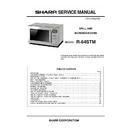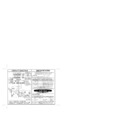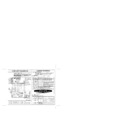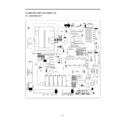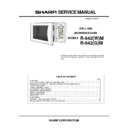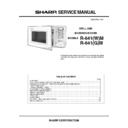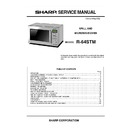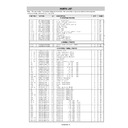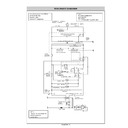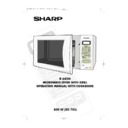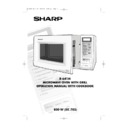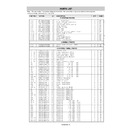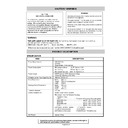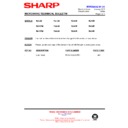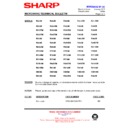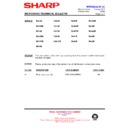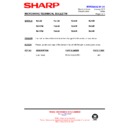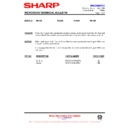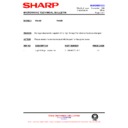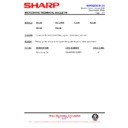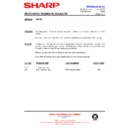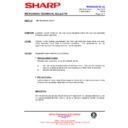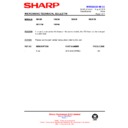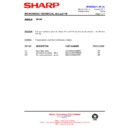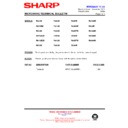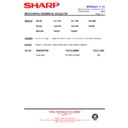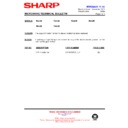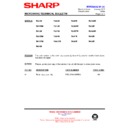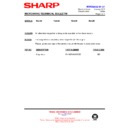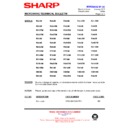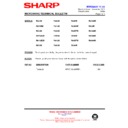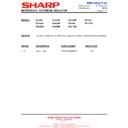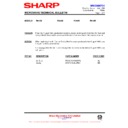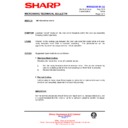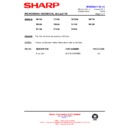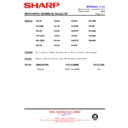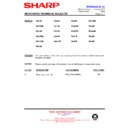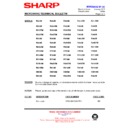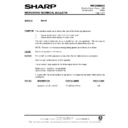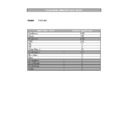Sharp R-64 (serv.man2) Service Manual ▷ View online
R-64STM -13
COMPONENT REPLACEMENT
DOOR REPLACEMENT
1.
CARRY OUT 3D CHECKS.
2.
Remove choke cover taking care not to break
clips by inserting an iron plate (thickness of about
0.5mm) or flat type screw driver to the gap between
the choke cover and door panel , Refer to page 22
(door parts).
clips by inserting an iron plate (thickness of about
0.5mm) or flat type screw driver to the gap between
the choke cover and door panel , Refer to page 22
(door parts).
3.
Remove door assembly by lifting and easing
it forward.
it forward.
4.
On reinstallation make sure the door is
parallel with the bottom line of the oven face
plate and the latch head pass through the
latch holes correctly.
parallel with the bottom line of the oven face
plate and the latch head pass through the
latch holes correctly.
5.
CARRY OUT 4R CHECKS.
NOTE : After any service to the door, the
approved microwave survey meter should be
used to assure in compliance with proper
microwave radiation standards.
used to assure in compliance with proper
microwave radiation standards.
Figure C-4. Door Assembly Replacement and
Adjustment
LATCH HEAD REMOVAL
1.
1.
Remove the choke as described in door
replacement.
replacement.
2.
Unhook the spring and lift the latch head clear.
3.
Replacement, the reverse of the above.
INNER DOOR FILM
Removal
1.
1.
Tear the door film from the door panel.
2.
Now the door film is free.
Installation
1.
1.
Tear away the backing film.
2.
Put the pasted side of the door film on the door
panel.
panel.
DOOR PANEL ASSEMBLY
1.
Remove the choke as described in door replacement.
2. Remove door assy by removing screws (4).
3. Remove Glass Stopper Screw (noting position of
stopper) and slide stopper down while lifting up.
stopper) and slide stopper down while lifting up.
4. Slide glass towards Glass Stopper position and then
down towards the lower edge of the door frame.
down towards the lower edge of the door frame.
5. Lift upper edge of glass, which will now be free from
upper clips and remove from lower clips.
upper clips and remove from lower clips.
6. Refitting is a reversal of the above when refitting,
ensure the glass and the glass stopper is in the original
position.
ensure the glass and the glass stopper is in the original
position.
1. CARRY OUT 3D CHECKS.
2. Remove the control panel assembly referring to
2. Remove the control panel assembly referring to
"CONTROL PANEL REPLACEMENT".
3. Remove the open lever from the oven cavity front plate
by removing the control panel assy.
4. Disconnect the leads from all switches.
5. Remove the one (1) screw holding the latch hook to
5. Remove the one (1) screw holding the latch hook to
the oven cavity.
6. Remove the latch hook.
7. Remove the switch(s) from the latch hook by pushing
7. Remove the switch(s) from the latch hook by pushing
the retaining tab backwards slightly and turning the
switch(s) on the post.
switch(s) on the post.
8. Now, the switch(s) is free.
LATCH SWITCH, MONITOR SWITCH AND STOP SWITCH REMOVAL
Figure C-6 Switches
Latch hook
Tab
SW3: Stop switch
SW2: Monitor switch
SW1: Monitored latch switch
Tab
Tab
Door film
Finger tab
Backing film
Figure C-5. Inner Door film
NOTE: When carrying out any repair to the door,
do not bend or warp the slit choke (tabs on
the door panel assembly) to prevent
microwave leakage.
PIN
PIN
LOWER
OVEN HINGE
OVEN HINGE
UPPER
OVEN HINGE
OVEN HINGE
LOWER
OVEN HINGE
OVEN HINGE
CHOKE COVER
DOOR
PANEL
PANEL
DOOR SUB
ASSEMBLY
ASSEMBLY
SLIT CHOKE
R-64STM -14
RE-WIRING
Ensure the following:
1.
Wires must not touch:
a)
High voltage parts.
(Magnetron, high voltage transformer, high voltage capacitor and high voltage rectifier assembly)
(Magnetron, high voltage transformer, high voltage capacitor and high voltage rectifier assembly)
b)
Parts that become hot.
(Heating elements, oven lamp, oven cavity magnetron and high voltage transformer)
(Heating elements, oven lamp, oven cavity magnetron and high voltage transformer)
c)
Sharp edges.
(Bottom plates, oven cavity, waveguide flange, chassis support and other metallic parts)
(Bottom plates, oven cavity, waveguide flange, chassis support and other metallic parts)
d)
Movable parts.
(Fan blade, any motor, switch, switch lever and open button)
(Fan blade, any motor, switch, switch lever and open button)
2.
Positive lock connectors are fitted correctly. Ensure the locking pin is located correctly.
3.
Wires are connected correctly as per pictorial diagram.
4.
No wire leads are trapped by the outer wrap.
WARNING: Before carrying out any work carry out 3D checks
1) Disconnect the supply.
2) Door opened, and wedged open.
3) Discharge high voltage capacitor.
WIRING / RE-WIRING
MICROWAVE MEASUREMENT
After any repair, the microwave oven must be checked for
microwave leakage to ensure continued safe operation
BS EN 60335-2-25 specifies that the maximum permitted
leakage with a load of 275ml is 50 W/m
microwave leakage to ensure continued safe operation
BS EN 60335-2-25 specifies that the maximum permitted
leakage with a load of 275ml is 50 W/m
2
(equivalent to
5mW/cm
2
) at a distance of 5cm from the oven.
PREPARATION
The following items are required to carry out this test:-
1.
1.
A low form of 600ml beaker made from
electrically non-conductive material, such as
glass or plastic, with an inside diameter of
approximately 8.5cm. This must contain 275
glass or plastic, with an inside diameter of
approximately 8.5cm. This must contain 275
±
15ml of water, at an initial temperature of 20
±
2
°C.
2.
A leakage detector which has been calibrated
within the preceding 12 months to a stand
whose accuracy can be traced to National
Physical Laboratory Standards.
whose accuracy can be traced to National
Physical Laboratory Standards.
Recommended instruments are:
Apollo "XI"
Celtec "A1000"
Celtec "A1000"
Before commencing the test, check the leakage detector is
functioning and adjusted according to the manufacturer's
instructions, and any spacers are fitted to ensure that
measurement is taken 5cm from the surface of the oven.
functioning and adjusted according to the manufacturer's
instructions, and any spacers are fitted to ensure that
measurement is taken 5cm from the surface of the oven.
Dotted line indicates the path taken by the leakage detector.
Whilst the maximum leakage permitted in BS EN 60335-2-25 is 50 W/m
2
(equivalent to 5mW/cm
2
), it is not
normal to detect anything significant, and therefore any detected leakage should be investigated.
PROCEDURE
1.
Place the beaker containing the water load
in the oven cavity at the centre of the
turntable. The placing of this standard load in
the oven is important, not only to protect the
oven, but also to ensure that any leakage it is
not disguised by too large a load absorbing
the energy.
in the oven cavity at the centre of the
turntable. The placing of this standard load in
the oven is important, not only to protect the
oven, but also to ensure that any leakage it is
not disguised by too large a load absorbing
the energy.
2.
Close the oven door, and with the power level
set to FULL, turn the oven ON with the timer
set for a few minutes operation. Should the
water begin to boil before the test has been
completed, it should be replaced.
set to FULL, turn the oven ON with the timer
set for a few minutes operation. Should the
water begin to boil before the test has been
completed, it should be replaced.
3.
As shown in the diagram below, move the
probe slowly (not faster than 2.5cm/sec);-
probe slowly (not faster than 2.5cm/sec);-
a)
around the edge of the door following the gap
b)
across the face of the door
c)
across any vents in the oven's sides, rear or
top
top
R-64STM -14
RE-WIRING
Ensure the following:
1.
Wires must not touch:
a)
High voltage parts.
(Magnetron, high voltage transformer, high voltage capacitor and high voltage rectifier assembly)
(Magnetron, high voltage transformer, high voltage capacitor and high voltage rectifier assembly)
b)
Parts that become hot.
(Heating elements, oven lamp, oven cavity magnetron and high voltage transformer)
(Heating elements, oven lamp, oven cavity magnetron and high voltage transformer)
c)
Sharp edges.
(Bottom plates, oven cavity, waveguide flange, chassis support and other metallic parts)
(Bottom plates, oven cavity, waveguide flange, chassis support and other metallic parts)
d)
Movable parts.
(Fan blade, any motor, switch, switch lever and open button)
(Fan blade, any motor, switch, switch lever and open button)
2.
Positive lock connectors are fitted correctly. Ensure the locking pin is located correctly.
3.
Wires are connected correctly as per pictorial diagram.
4.
No wire leads are trapped by the outer wrap.
WARNING: Before carrying out any work carry out 3D checks
1) Disconnect the supply.
2) Door opened, and wedged open.
3) Discharge high voltage capacitor.
WIRING / RE-WIRING
MICROWAVE MEASUREMENT
After any repair, the microwave oven must be checked for
microwave leakage to ensure continued safe operation
BS EN 60335-2-25 specifies that the maximum permitted
leakage with a load of 275ml is 50 W/m
microwave leakage to ensure continued safe operation
BS EN 60335-2-25 specifies that the maximum permitted
leakage with a load of 275ml is 50 W/m
2
(equivalent to
5mW/cm
2
) at a distance of 5cm from the oven.
PREPARATION
The following items are required to carry out this test:-
1.
1.
A low form of 600ml beaker made from
electrically non-conductive material, such as
glass or plastic, with an inside diameter of
approximately 8.5cm. This must contain 275
glass or plastic, with an inside diameter of
approximately 8.5cm. This must contain 275
±
15ml of water, at an initial temperature of 20
±
2
°C.
2.
A leakage detector which has been calibrated
within the preceding 12 months to a stand
whose accuracy can be traced to National
Physical Laboratory Standards.
whose accuracy can be traced to National
Physical Laboratory Standards.
Recommended instruments are:
Apollo "XI"
Celtec "A1000"
Celtec "A1000"
Before commencing the test, check the leakage detector is
functioning and adjusted according to the manufacturer's
instructions, and any spacers are fitted to ensure that
measurement is taken 5cm from the surface of the oven.
functioning and adjusted according to the manufacturer's
instructions, and any spacers are fitted to ensure that
measurement is taken 5cm from the surface of the oven.
Dotted line indicates the path taken by the leakage detector.
Whilst the maximum leakage permitted in BS EN 60335-2-25 is 50 W/m
2
(equivalent to 5mW/cm
2
), it is not
normal to detect anything significant, and therefore any detected leakage should be investigated.
PROCEDURE
1.
Place the beaker containing the water load
in the oven cavity at the centre of the
turntable. The placing of this standard load in
the oven is important, not only to protect the
oven, but also to ensure that any leakage it is
not disguised by too large a load absorbing
the energy.
in the oven cavity at the centre of the
turntable. The placing of this standard load in
the oven is important, not only to protect the
oven, but also to ensure that any leakage it is
not disguised by too large a load absorbing
the energy.
2.
Close the oven door, and with the power level
set to FULL, turn the oven ON with the timer
set for a few minutes operation. Should the
water begin to boil before the test has been
completed, it should be replaced.
set to FULL, turn the oven ON with the timer
set for a few minutes operation. Should the
water begin to boil before the test has been
completed, it should be replaced.
3.
As shown in the diagram below, move the
probe slowly (not faster than 2.5cm/sec);-
probe slowly (not faster than 2.5cm/sec);-
a)
around the edge of the door following the gap
b)
across the face of the door
c)
across any vents in the oven's sides, rear or
top
top
R-64STM -14
RE-WIRING
Ensure the following:
1.
Wires must not touch:
a)
High voltage parts.
(Magnetron, high voltage transformer, high voltage capacitor and high voltage rectifier assembly)
(Magnetron, high voltage transformer, high voltage capacitor and high voltage rectifier assembly)
b)
Parts that become hot.
(Heating elements, oven lamp, oven cavity magnetron and high voltage transformer)
(Heating elements, oven lamp, oven cavity magnetron and high voltage transformer)
c)
Sharp edges.
(Bottom plates, oven cavity, waveguide flange, chassis support and other metallic parts)
(Bottom plates, oven cavity, waveguide flange, chassis support and other metallic parts)
d)
Movable parts.
(Fan blade, any motor, switch, switch lever and open button)
(Fan blade, any motor, switch, switch lever and open button)
2.
Positive lock connectors are fitted correctly. Ensure the locking pin is located correctly.
3.
Wires are connected correctly as per pictorial diagram.
4.
No wire leads are trapped by the outer wrap.
WARNING: Before carrying out any work carry out 3D checks
1) Disconnect the supply.
2) Door opened, and wedged open.
3) Discharge high voltage capacitor.
WIRING / RE-WIRING
MICROWAVE MEASUREMENT
After any repair, the microwave oven must be checked for
microwave leakage to ensure continued safe operation
BS EN 60335-2-25 specifies that the maximum permitted
leakage with a load of 275ml is 50 W/m
microwave leakage to ensure continued safe operation
BS EN 60335-2-25 specifies that the maximum permitted
leakage with a load of 275ml is 50 W/m
2
(equivalent to
5mW/cm
2
) at a distance of 5cm from the oven.
PREPARATION
The following items are required to carry out this test:-
1.
1.
A low form of 600ml beaker made from
electrically non-conductive material, such as
glass or plastic, with an inside diameter of
approximately 8.5cm. This must contain 275
glass or plastic, with an inside diameter of
approximately 8.5cm. This must contain 275
±
15ml of water, at an initial temperature of 20
±
2
°C.
2.
A leakage detector which has been calibrated
within the preceding 12 months to a stand
whose accuracy can be traced to National
Physical Laboratory Standards.
whose accuracy can be traced to National
Physical Laboratory Standards.
Recommended instruments are:
Apollo "XI"
Celtec "A1000"
Celtec "A1000"
Before commencing the test, check the leakage detector is
functioning and adjusted according to the manufacturer's
instructions, and any spacers are fitted to ensure that
measurement is taken 5cm from the surface of the oven.
functioning and adjusted according to the manufacturer's
instructions, and any spacers are fitted to ensure that
measurement is taken 5cm from the surface of the oven.
Dotted line indicates the path taken by the leakage detector.
Whilst the maximum leakage permitted in BS EN 60335-2-25 is 50 W/m
2
(equivalent to 5mW/cm
2
), it is not
normal to detect anything significant, and therefore any detected leakage should be investigated.
PROCEDURE
1.
Place the beaker containing the water load
in the oven cavity at the centre of the
turntable. The placing of this standard load in
the oven is important, not only to protect the
oven, but also to ensure that any leakage it is
not disguised by too large a load absorbing
the energy.
in the oven cavity at the centre of the
turntable. The placing of this standard load in
the oven is important, not only to protect the
oven, but also to ensure that any leakage it is
not disguised by too large a load absorbing
the energy.
2.
Close the oven door, and with the power level
set to FULL, turn the oven ON with the timer
set for a few minutes operation. Should the
water begin to boil before the test has been
completed, it should be replaced.
set to FULL, turn the oven ON with the timer
set for a few minutes operation. Should the
water begin to boil before the test has been
completed, it should be replaced.
3.
As shown in the diagram below, move the
probe slowly (not faster than 2.5cm/sec);-
probe slowly (not faster than 2.5cm/sec);-
a)
around the edge of the door following the gap
b)
across the face of the door
c)
across any vents in the oven's sides, rear or
top
top

